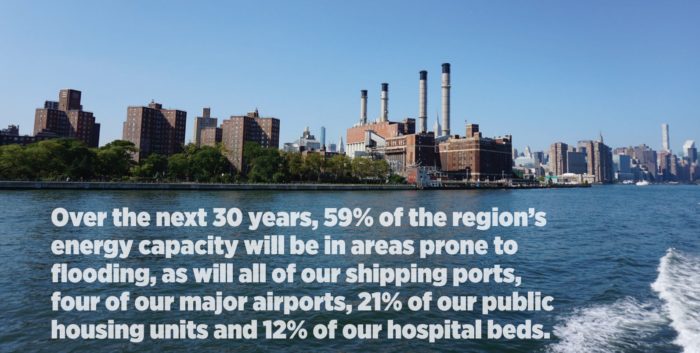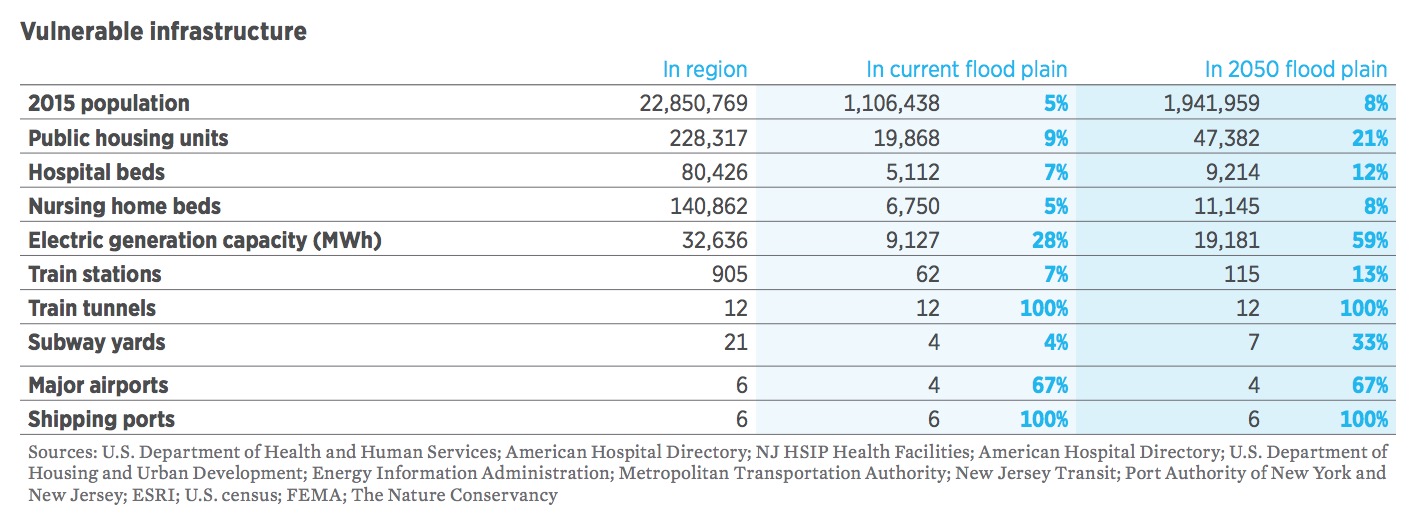REGIONAL PLAN ASSOCIATION (RPA)
Executive Summary
 Over the next 30 years, the number of people living in places at risk of flooding from an extreme storm in the New York-New Jersey-Connecticut region is likely to double from 1 million to 2 million. Sea levels are projected to rise by two feet, putting 10,000 homes permanently under water and greatly expanding the coastal floodplain. With over 3,700 miles of tidal coastline, much of it densely populated with old and decaying infrastructure, the region’s states and local communities face the daunting challenge of making the physical and regulatory changes necessary to adapt to this new coastline. Restoring wetlands, building sea walls, raising buildings, retrofitting infrastructure and buying out vulnerable homeowners are among the actions that 167 coastal cities, towns, villages and counties will need to consider and find the resources to implement.
Over the next 30 years, the number of people living in places at risk of flooding from an extreme storm in the New York-New Jersey-Connecticut region is likely to double from 1 million to 2 million. Sea levels are projected to rise by two feet, putting 10,000 homes permanently under water and greatly expanding the coastal floodplain. With over 3,700 miles of tidal coastline, much of it densely populated with old and decaying infrastructure, the region’s states and local communities face the daunting challenge of making the physical and regulatory changes necessary to adapt to this new coastline. Restoring wetlands, building sea walls, raising buildings, retrofitting infrastructure and buying out vulnerable homeowners are among the actions that 167 coastal cities, towns, villages and counties will need to consider and find the resources to implement.
While there has been substantial progress in planning for climate change, adaptation is slow, sporadic, underfunded and uncoordinated. Attention and resources rise in the wake of storms like Superstorm Sandy, but soon dissipate when the immediate crisis has passed. In many ways, the needs are so great and the timeframes for implementation are so long that it is easier to focus on more immediate needs. While Superstorm Sandy provided an infusion of funding for recovery and adaptation, there remains $28 billion worth of identified needs that has not been funded.1 To get ahead of the growing crisis, the region will need to overcome several impediments:
- Planning and investments are reactive rather than proactive. There is neither a plan nor a budget for adaptation projects that can prioritize investments and prepare for future contingencies. Instead, current funding sources and policies depend on unreliable federal funding that promotes short-term recovery over long-term investments.
- Most of the region’s smaller cities, towns and villages have limited capacity. The vast majority of the region’s municipalities are governed by part-time or volunteer mayors and councils, and even the larger municipalities lack the staff capacity and resources to address and plan for long-term climate changes.
- Coastal flooding is a regional problem, but most planning happens locally. Each state and municipality has different rules, policies and guidelines, and limited incentives to collaborate. Coastlines and infrastructure transverse government boundaries, and since water is fluid, management practices in one state or municipality can have an inadvertent impact on others.
- State coastal management programs leave several problems unaddressed. The coastal management programs of the three states vary widely in approach, and inconsistent policies can prevent important adaptation strategies from being implemented across state lines.At the same time, adaptation is not a singular focus of any program, nor are issues of regional significance, such as infrastructure.
A Coastal Commission for the Tri-State Region
To give climate adaptation the priority it needs and to be able to implement solutions at different geographic scales, New York, New Jersey and Connecticut should create a Regional Coastal Commission (RCC). The commission would be empowered to maintain a dedicated focus on the region’s climate adaptation needs, help mobilize the region’s resources to address them, coordinate strategies and develop common standards. It would also prioritize funding that can be used for region-wide resilience projects. Based on successes and lessons learned from other coastal commissions, the RCC would have the following responsibilities:
- Produce and update a regional coastal adaptation plan that aligns policies across municipal and state boundaries and sets a vision for short-term resilience and longterm adaptation.
- Develop and manage science-informed standards to guide and prioritize adaptation projects and development in the region’s at-risk geographies
- Coordinate and encourage collaborative adaptation projects across municipal and state boundaries.
- Evaluate and award funding from new adaptation trust funds that align with standards established by the commission.
State Adaptation Trust Funds
The Regional Coastal Commission needs funding to fulfill its mission. We propose establishing new dedicated resources from adaptation trust funds to be established in each state. The trust funds would be organized as public benefit corporations and would be initially capitalized from surcharges on property and casualty premiums. The funds would be managed by each state, but oversight and authority to underwrite and allocate the funds as grants and loans would rest with the commission. Each state trust fund would finance a minimum amount of in-state projects, while residual allocations would be prioritized for those projects and programs whose benefits would extend beyond jurisdictional boundaries. The grants and loans could support a range of projects, from short-term community resilience planning to long-term infrastructure finance and could be used to leverage or match other funding sources. Through the utilization of bond leverage, the funds could operate independently and without subsidy from the insurance surcharges within a 10 year sunset period.
Coastal Commission Governance
Membership and governance of the Regional Coastal Commission could take a number of forms, but should be guided by the best practices of other coastal commissions and regional collaboratives. Members should be designated across jurisdictions (state, county and local) and should be representative of different coast types (urban, suburban and more natural conditions). Elected officials could have a role on the commission to give it legitimacy and visibility, but the governance structure must remain independent from political cycles and direct political interference. Both members and staff should include a variety of disciplines to embed all aspects of resilience planning into decisions. The commission’s work should be informed by the latest science and flexible enough to shift as conditions along the dynamic coast change over time. Funding allocations and project selection should be guided by a clear set of standards and evaluation metrics.
About Regional Plan Association (RPA)
www.rpa.org
For 90 years, Regional Plan Association has been an indispensable source of ideas and plans for policy makers and opinion shapers across the tri-state region. RPA is America’s most distinguished urban research and advocacy organization. RPA works to improve the prosperity, infrastructure, sustainability and quality of life of the New York-New Jersey-Connecticut metropolitan region. Some of the region’s most significant public works, economic development and open space projects have their roots in RPA ideas and initiatives, from the location of the George Washington Bridge to the revitalization of downtown Brooklyn, Stamford and Newark to the preservation of open space and development of parks in the Palisades, Governors Island and Gateway National Recreation Area.
Tags: Climate, Coastal Adaptation, Regional Plan Association, RPA, Tri-State Area







 RSS Feed
RSS Feed